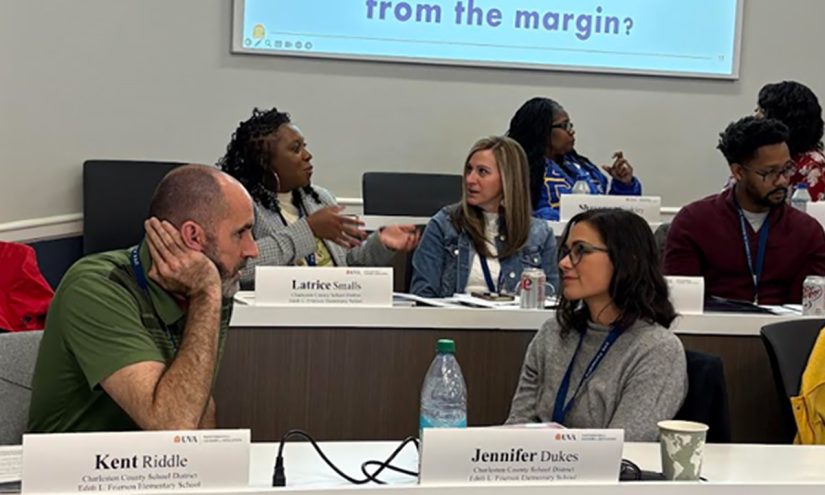Get stories like this delivered straight to your inbox. Sign up for The 74 Newsletter
Latrice Smalls’ first year as principal of South Carolina’s Edith L. Frierson Elementary in 2023 came with a hefty task: improve the school’s unsatisfactory state report card rating.
With roughly 160 students — nearly two-thirds of them low-income — the rural Charleston County school recorded math and reading test scores well below district and state averages. One-third of students were chronically absent, and school climate was ranked low by teachers.
“The school was a failing school, and it had been a failing school for a few years,” Smalls said.
Smalls’s first year coincided with the school’s acceptance into the University of Virginia Partnership for Leaders in Education, a program that helps improve low-performing schools through administrator training and professional development.
Frierson Elementary is one of three schools that transformed from struggling to succeeding because of the turnaround program. After one year, the school went from an unsatisfactory to excellent rating, the highest performance tier in the state’s report card system.
Since 2004, the partnership has worked with more than 900 schools from 33 states. Roughly half achieve double-digit gains in reading, math or both, within three years of starting the program.
For two to three years, administrators receive professional development at the university and coaches visit their schools to help brainstorm ways to improve academic achievement, attendance and culture. Districts must apply and, if selected, pay roughly $90,000 for program costs.
Leighann Lenti, the program’s chief of partnership, said the key to transforming a low-performing is to work with district and building administrators to make systemic changes that will lead to improved student outcomes.
“They’re given a chance to think about the design and the decisions they’re making in their buildings and in their school district,” Lenti said. “[They] think about their highest priorities and the root cause of what hasn’t worked, so they can solve those problems differently — not just keep doing the same things over and over — and see tangible results for kids.”
A 2016 University of Chicago study found that 20 Ohio schools that participated in the program saw statistically significant academic improvement that persisted even two years after completion.
The program focuses on four areas of school improvement: system leadership, support and accountability, talent management and instructional infrastructure.
During the first year, University of Virginia staff work with district and school leaders to develop a plan for their school. They try to find root causes for low performance and create goals that are revised every 90 days.
Administrators at Schoolfield Elementary in Danville, Virginia, started the program before the 2023-24 school year and finished in January. Principal Kelsie Hubbard and her colleagues created a 90-day plan with three main areas of focus: professional learning, classroom instruction and teaching strategies.
Educators began professional development twice a week to make sure instruction and activities matched existing rigorous academic standards. They also worked to ensure students were being taught the same way in every classroom, so they didn’t have to relearn strategies if they changed grades or teachers.
“Coming out of COVID, we were seeing a lot of our students performing below grade level, and so a trend we started to notice is that our instruction was not meeting the rigor of the standards,” Hubbard said.”We were teaching lower level because we were assuming that students needed that intensive intervention. … But we were holding and keeping them further and further behind.”
At the end of the program, Schoolfield — a building of 500 students, with 85% low-income — improved its reading proficiency from 68% in 2023 to 78% in 2024. Math proficiency went from 68% to 73%.
Similar gains were observed in Alabama’s Florence City Schools, a district of 4,500 students that recently finished the program. Three of its lowest-performing elementary schools that participated all reported improvements in reading, math and chronic absenteeism.
Superintendent Jimmy Shaw said principals met with reading and math teachers to brainstorm why academic scores were lacking.
For example, they found in Weeden Elementary that third graders had a hard time with geometry and other math topics while taking state assessments. Teachers began to give 10-minute mini-lessons daily to help students master specific skills.
“It’s been beautiful work to be able to build the capacity of our leaders and our research teams. To us, that’s what it’s about,” Shaw said. “It’s not about having some dynamic leader, but it’s about building the capacity of a group of adults who can understand system structures and processes to be able to attack a problem.”
Smalls’ 90-day plan for Frierson Elementary began with a list of goals such as improving school climate by training educators and ensuring they got enough classroom time to teach the? curriculum. She also delivered a “state of the school” address for families to explain Frierson’s unsatisfactory rating and what steps were being taken to fix it. Teachers hosted literacy and math nights to get parents more involved in their child’s learning.
“I felt like I created an environment, a climate or a culture where everybody was valued and everybody was seen as a leader,” Smalls said. “[The program] is very effective. It is very self-provoking, very reflective, very action-based and action-oriented. I really believe in it.”
Get stories like these delivered straight to your inbox. Sign up for The 74 Newsletter








